Carbide end mills, with their high hardness, wear resistance, and excellent cutting stability, are essential tools for improving productivity in CNC milling. Compared to traditional high speed steel (HSS) end mills, solid carbide end mills maintain a sharp cutting edge at higher speeds and feed rates, reducing tool changes and downtime, which significantly improves overall production line utilization. They are particularly effective when machining high-strength materials such as hardened steel, titanium alloys, and mold steel.
The number of flutes in a solid carbide end mill directly impacts productivity. For instance, choosing between a 2 flute vs 4 flute solid carbide end mill affects chip evacuation, surface finish, and tool life. Two flute milling cutters excel in high-speed cutting of soft materials like aluminum, while four-flute cutters provide more stable cutting forces and finer surface finishes for steel finishing.
For manufacturers aiming to balance precision and productivity, knowing how to choose solid carbide end mills for CNC machining is critical. Beyond geometry and material, considerations include machining methods, workpiece materials, and coating types. Many customers also turn to reliable solid carbide end mill manufacturers or carbide end mill factories in China for OEM or custom solutions, ensuring tools meet production schedules and performance requirements.
Overall, solid carbide end mills offer higher cutting efficiency, longer tool life, and help manufacturers achieve cost reduction, increased efficiency, and precise machining in competitive environments.
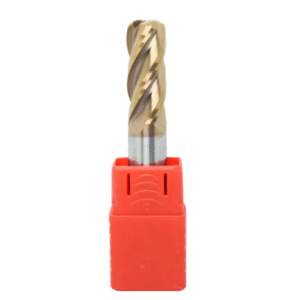
Why Production Efficiency Depends on Tool Performance
Tool performance directly affects machining efficiency, workpiece accuracy, and production line stability. Whether in mold making, automotive parts, or mass metalworking, a tool’s material, geometry, and coating determine each cut’s quality. High-performance tools enable faster cutting, longer life, fewer interruptions, higher yield rates, and more predictable production cycles.
Without adequate tool performance, even advanced CNC machines cannot reach their full potential. Optimized solid carbide end mills maintain a stable edge at high speeds and depths, achieving higher material removal rates (MRR). Advanced coatings like TiAlN, AlCrN, or nano-coatings further reduce wear and thermal deformation, supporting long-term continuous machining.
The Relationship Between Cutting Efficiency, Tool Life, and Machining Accuracy
Cutting efficiency, tool life, and machining accuracy are tightly connected. Higher cutting speeds increase material removal, but unsuitable tool materials or geometry can accelerate wear, degrade surface finish, and increase dimensional errors.
For example, conventional HSS end mills in mass mold production wear quickly, requiring frequent replacements and causing downtime. Solid carbide end mills, with high hardness and heat resistance, operate continuously under high-temperature conditions, extending tool life and improving dimensional consistency. Longer tool life reduces tool changes and maintains stable accuracy during extended cuts, boosting overall production efficiency.
Why Selecting High-Performance Tools is Critical for Production Stability
Production line stability often outweighs individual processing speed. Frequent replacements of low-end tools waste time and can introduce dimensional inconsistencies and uneven workpiece quality.
High-performance tools from professional solid carbide end mill manufacturers or carbide end mill factories in China utilize ultrafine-grain tungsten carbide matrices and precision grinding with advanced coatings. These tools resist wear and chipping, reducing interruptions and maintaining consistent surface quality.
For automated or long-duration cutting tasks, stable solid carbide end mills maximize equipment utilization, reduce downtime, and ensure consistent precision across workpieces, delivering a highly efficient, cost-effective CNC production system.

The Core Advantages of Solid Carbide End Mills in CNC Machining
Solid carbide end mills have gradually replaced HSS tools in high-speed and precision milling. Their ultrafine tungsten carbide and cobalt matrix provides high strength and red hardness, maintaining sharp edges under high-load, high-temperature conditions.
Compared to traditional tools, carbide end mills operate at higher speeds with stable cutting performance in hard materials, mold steel, and stainless steel. They significantly increase material removal rates, extend tool life, and reduce scrap, making them ideal for high-efficiency precision manufacturing.
High Hardness and Wear Resistance: Foundation for Extended Tool Life
The dense microstructure of carbide end mills, with micron- or nano-sized tungsten carbide particles bonded by cobalt, delivers superior wear resistance and compressive strength. Compared to HSS, which softens above ~600°C, carbide tools remain effective above 900°C, enabling higher speeds and longer life when cutting hardened steel, tool steel, or stainless steel.
High Rigidity and Vibration Resistance: Ensuring High-Precision Machining
Carbide’s higher elastic modulus reduces vibration and tool deflection, preserving surface accuracy and contour consistency. This is critical in deep-cavity mold machining and aerospace part milling, especially with long-overhang tools. High-rigidity carbide cutters maintain stable cutting forces, ensuring dimensional accuracy and excellent surface finish.
High-Speed Cutting Capability: Improving Material Removal Rate
Carbide end mills sustain high spindle speeds and feed rates without compromising edge integrity. With appropriate coatings (TiAlN, AlCrN) and optimized geometry, they resist wear even under dry or coolant-free cutting, outperforming HSS tools in cycle time, surface finish, and reduced thermal cracking.
Additionally, proper tool design—such as high helix angles, optimized flute geometry, and sharp cutting edges—enhances cutting stability, enabling excellent performance in high-speed machining of aluminum, titanium, and composite materials. Selecting high-performance solid carbide end mills is crucial for manufacturers pursuing automated, high-efficiency production.
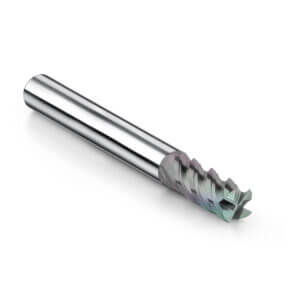
How Flute Count Affects Machining Efficiency: 2 Flute vs 4 Flute Analysis
In CNC milling, flute count is a critical factor that influences cutting efficiency, chip evacuation, surface finish, and overall tool life. Solid carbide end mills (SCMs) with different flute counts show distinct structural characteristics, directly affecting cutting stability, heat dissipation, and machining precision.
For manufacturers aiming to maximize both productivity and accuracy, understanding the differences between 2-flute and 4-flute SCMs is essential for optimizing process parameters and reducing production costs. Selecting the right flute count not only enhances chip evacuation and temperature control but also balances machining efficiency and tool longevity across various materials, including aluminum alloys, stainless steel, and mold steel.
Structural Differences Between 2 Flute and 4 Flute SCMs
The design of 2-flute and 4-flute SCMs determines their performance in specific machining scenarios. Two-flute end mills feature wider chip flutes, which improve chip evacuation and heat dissipation when cutting soft metals like aluminum, copper, and plastics. The larger flute volume minimizes chip clogging, maintains a smooth cutting surface, and prolongs tool life.
In contrast, four-flute solid carbide end mills have more cutting edges and denser distribution of contact points, providing greater cutting stability and superior surface finish when machining harder materials such as steel, alloy steel, or hardened steel. The narrower spacing between edges increases vibration resistance at high cutting speeds, making them ideal for finishing, side milling, and precision contouring operations.
With advances in cutting tool technology, many solid carbide end mill manufacturers are developing multi-flute cutters that optimize helix angles and flute geometry, combining excellent chip evacuation with rigidity to meet the demands of complex, multi-process milling.
Selecting the Optimal Number of Flutes Based on Material
Choosing the correct flute count depends on the material properties of the workpiece and the machining strategy. For soft materials like aluminum, copper, or engineering plastics, 2-flute solid carbide end mills are optimal. Their wide flutes efficiently evacuate chips, reduce the risk of chip sticking, and maintain stable cutting temperatures and smooth surface finishes. Polished flute surfaces further enhance high-speed performance, especially in aluminum machining.
For harder materials such as mold steel, carbon steel, and stainless steel, 4 flute solid carbide end mills provide higher rigidity and balanced cutting forces, resulting in improved material removal rates and more consistent finishes. Each cutting edge removes a smaller volume of material per pass, reducing load on individual teeth and increasing tool life. Coatings such as TiAlN, AlCrN, or DLC further enhance wear resistance and performance under high-speed or dry cutting conditions.
From an engineering perspective, flute count selection influences not only cutting efficiency but also overall production cycle optimization. In mass production, higher-flute-count tools reduce tool changes and extend life, while lower-flute-count tools enable rapid material removal in roughing or rapid prototyping. Strategically combining different flute designs allows manufacturers to achieve maximum productivity, precision, and efficiency in CNC milling operations.
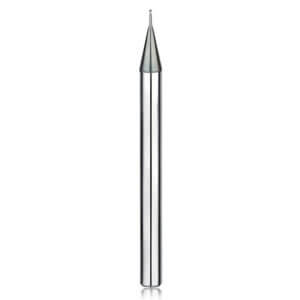
How to Choose the Right Carbide End Mill for CNC Machining
Selecting the right carbide end mill is crucial for achieving high-efficiency, high-precision CNC machining. Proper tool selection affects cutting speed, tool life, surface quality, and production costs, while directly impacting equipment utilization. In industries such as mold manufacturing, aerospace parts, and mass-produced metal components, choosing the optimal solid carbide end mill helps maximize material removal rate (MRR) and minimize scrap, while maintaining consistent machining accuracy.
Tool selection should consider multiple factors, including workpiece material, machining type, production model, tool coating, edge profile, helix angle, and number of flutes. These factors are critical for improving cutting stability, reducing tool wear, and achieving high-efficiency CNC milling.
Starting from the Workpiece Material: Steel, Aluminum, Titanium, and Graphite
Workpiece material is the primary consideration when selecting solid carbide end mills for CNC machining:
-
Steel and Stainless Steel: Four-flute carbide end mills are ideal. A high helix angle enhances chip evacuation, while coatings such as TiAlN or AlCrN improve wear resistance and red hardness.
-
Aluminum and Soft Alloys: Two-flute end mills with wide chip flutes facilitate efficient chip evacuation, reduce cutting temperatures, and prevent surface roughness or tool sticking.
-
Titanium Alloys: Medium-flute tools with high-performance coatings help manage cutting heat and extend tool life.
-
Graphite or Composite Materials: Tools require sharp edges and smooth chip evacuation; coatings prevent material adhesion and sticking.
Selecting the correct tool based on material improves machining efficiency, surface finish, and minimizes downtime or scrap caused by inappropriate tooling.
Based on Machining Type: Roughing vs. Finishing
-
Roughing: Focus on high material removal. Low-flute-count tools (2-3 flutes) with wide chip flutes and high wear resistance are preferred. These tools allow high feed rates and rapid MRR.
-
Finishing: Focus on surface quality and dimensional accuracy. High-flute-count tools (4-5 flutes) with moderate helix angles reduce vibration and enhance cutting stability. Coatings further extend tool life.
A proper combination of roughing and finishing tools shortens overall machining cycles while ensuring consistent surface quality and dimensional precision.
Production Model: Single-Piece Prototyping vs. Mass Production
-
Single-Piece Prototyping: Prioritizes flexibility and stability. Standard or general-purpose carbide tools suffice for rapid completion of prototypes.
-
Mass Production: Prioritizes tool life, dimensional consistency, and cost control. Selecting high-performance carbide end mills from a reliable manufacturer or carbide end mill factory in China reduces tool changes, downtime, and ensures batch consistency.
Considering material, machining type, and production model is essential for achieving efficient CNC milling and reducing unit machining costs.

Advantages and Trends in Chinese Carbide End Mill Manufacturing
In recent years, China’s carbide end mill industry has made significant progress in technology research and development, production processes, and quality control, becoming a major supplier to the global tooling market. By continuously optimizing powder metallurgy processes, improving sintering precision, and adopting advanced coating technologies such as TiAlN, AlCrN, and DLC, Chinese tool manufacturers have enhanced wear resistance, red hardness, and achieved microstructural uniformity and cutting-edge sharpness comparable to leading international brands.
Stringent testing standards and quality management systems ensure dimensional consistency and reliable performance in mass-produced tools. For buyers, selecting a solid carbide end mill manufacturer or carbide end mill factory in China with strong technical capabilities not only offers cost advantages but also ensures tools meet international performance standards.
The Technical Level and Global Competitiveness of Carbide End Mill Factories in China
Chinese tool manufacturers are increasingly closing the gap with international counterparts. Advanced CNC grinding machines, laser grooving technology, and high-precision coating processes improve tool edge sharpness and tool life. Automated production lines and online inspection systems ensure consistent and reliable tooling during mass production.
These technological upgrades enhance the global competitiveness of Chinese manufacturers and meet the demand for high-performance tools in industries requiring high precision, such as mold making, aerospace, and automotive components. Overseas customers can maintain high-quality machining while reducing procurement costs by sourcing from a reliable Chinese carbide end mill factory.
OEM/ODM Customization Services Help Overseas Customers Improve Production Efficiency
With growing demand for high-precision, high-efficiency machining, B-end customers increasingly rely on Chinese manufacturers for OEM/ODM solutions. Customized carbide end mills can adjust cutting edge shape, flute number, helix angle, and coating type based on workpiece material, machining method, tool life requirements, and desired surface finish. This achieves optimal cutting efficiency, maximizes tool life, reduces tool changes, and ensures consistent quality across mass production batches.
Through these customized services, Chinese manufacturers help overseas customers optimize CNC machining processes, improve production efficiency, and reduce overall manufacturing costs.

Practical Tips and Parameter Optimization for Improving CNC Productivity
Even high-performance solid carbide end mills cannot achieve their full potential without proper cutting parameters. Optimizing feed rates, cutting speeds, number of flutes, and cooling strategies significantly increases material removal rate (MRR), extends tool life, and reduces machining costs.
Parameter optimization applies not only to mass production but also to single-piece prototypes and complex parts. Correct settings minimize tool wear and vibration, ensure surface quality and dimensional accuracy, and achieve high-efficiency CNC milling. Tool selection combined with parameter optimization tailored to different materials is key to maximizing efficiency.
Achieving Optimal Tool Performance Through Feed Rate and Cutting Speed
Feed rate and cutting speed directly determine cutting forces and heat generation. For hardened steel, higher spindle speeds with moderate feed rates maximize carbide heat resistance and hardness while minimizing wear. When machining soft materials like aluminum or copper, two-flute solid carbide end mills can operate at higher feed rates and cutting speeds for faster MRR and smooth chip evacuation. In finishing or hard-material applications, four-flute end mills are suitable for lower feed rates and stable speeds to ensure dimensional accuracy and surface finish.
Optimizing parameters based on tool grade, flute number, and workpiece material improves tool life, machining efficiency, and production line stability.
Matching Cooling Methods with Tool Coatings for Optimal CNC Milling Performance
Tool cooling affects both tool life and machining stability. Carbide tools can generate high temperatures during high-speed cutting. Without effective cooling, edge wear accelerates, or thermal cracks may occur. Cooling methods should match tool material and coating type:
-
Dry Milling: Suitable for well-coated carbide tools (TiAlN, AlCrN), reduces liquid contamination while maintaining high efficiency.
-
Air Cooling: Reduces heat in lighter materials, suitable for moderate heat-resistant tools.
-
Mist or Liquid Cooling (MQL/Lubrication): For high-temperature, high-hardness materials (like hardened steel) or deep-hole milling, extends tool life, reduces cutting temperatures, and improves surface finish.
Choosing the right cooling strategy considering tool coating, workpiece material, and machining method ensures stable, efficient CNC milling and prolongs tool life.

High-Performance Carbide End Mills Achieve High Efficiency and Low Costs
In CNC milling, tool performance is the key factor determining machining efficiency, surface quality, and production costs. Solid carbide end mills offer superior red hardness, wear resistance, and rigidity compared to HSS, enabling high-speed, high-precision machining while extending tool life and reducing downtime from frequent tool changes.
Flute design selection depends on material and machining type: 2-flute tools are ideal for high-speed roughing of soft materials, while 4-flute tools excel in finishing and high-precision contouring of hard materials. Proper flute design optimizes chip evacuation, cutting stability, and surface finish.
Combined with optimized helix angles, coatings, cutting parameters , and suitable cooling methods (dry, air, or MQL), manufacturers can maximize tool performance, extend tool life, and increase material removal rate per unit time. Production strategies should differ by model: prototyping focuses on flexibility, while mass production balances tool life, cost, and consistency.
Finally, sourcing from a reliable solid carbide end mill manufacturer or carbide end mill factory in China ensures access to high-performance tools and OEM/ODM support, maintaining stable production for high-precision applications such as mold manufacturing, aerospace, and automotive components.
By scientifically selecting tools and optimizing parameters, coupled with material advantages, flute design, coating technology, and cooling strategies, manufacturers can achieve high-efficiency, low-cost, and stable CNC machining, while maintaining precision and improving production capacity and economic benefits.



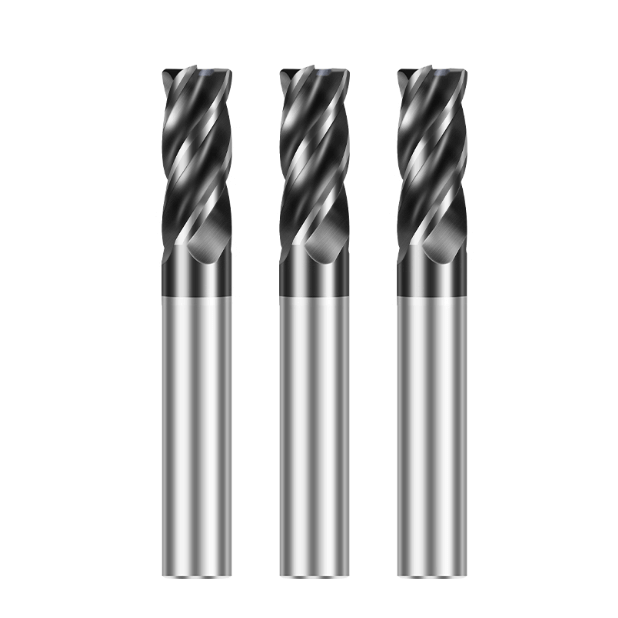


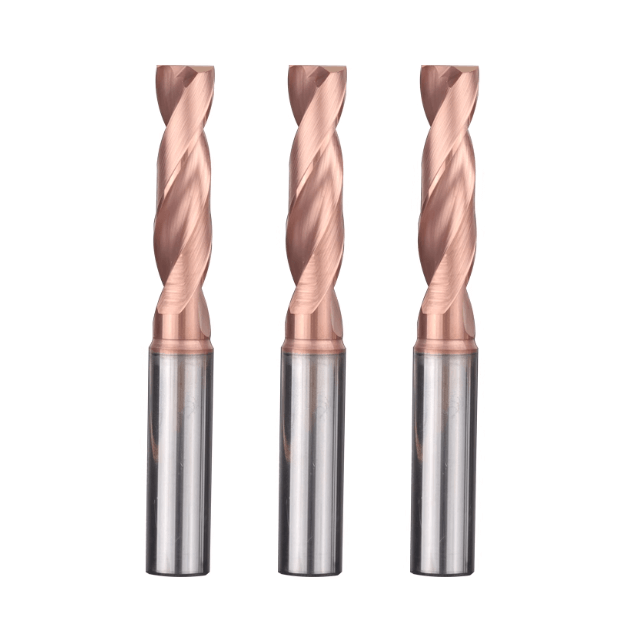

-白底主图2.jpg)
